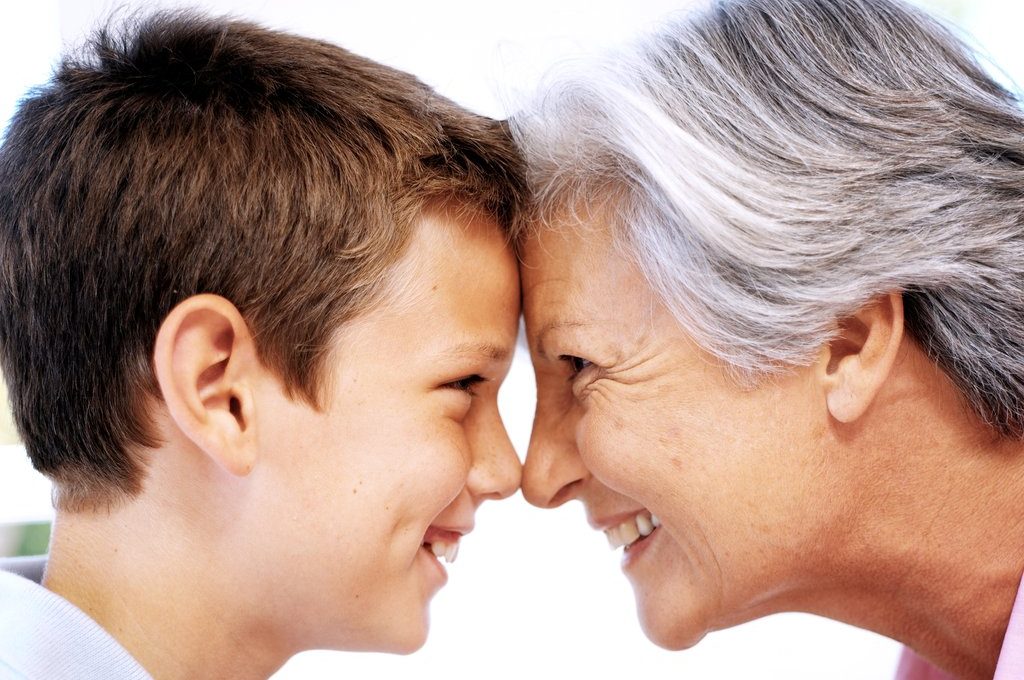They need you in their lives—and you need them
By Wendy Haaf
Photo: iStock/bowdenimages.
If you’ve recently joined the ranks of Canada’s 7.1 million grandparents, or will be doing so soon, you might be wondering how you’re going to go about building a strong bond with the newest member of the family. And that’s definitely a worthy goal, since mounting evidence suggests that a close, supportive, emotional connection between grandkids and grandparents confers benefits on both, from enhancing social and school involvement in youngsters to having a positive impact on mental health in both generations.
“Grandparents provide another level of social exposure and social contact that has been shown to be really important to a child’s development,” says Kelly Dean Schwartz, an associate professor in School and Applied Psychology at the University of Calgary’s Werklund School of Education.
Among other things, Grandma and Grandpa can expose the youngest generation to a broader range of experiences than they might otherwise encounter. At the same time, chasing grandkids around and trying to keep up with their interests can inspire grandparents to be more physically and socially active, and to challenge their brains by learning new skills.
“Sometimes we go to those indoor amusement places, and they’ll get me to do crazy things,” Robert Brown of Bedford, NS, says of his daughter’s two younger children. “I’ll think, It’s just a small slide, and I get on it and realize that I’m nearly 70 years old!”
For ideas on how to go about fostering a bond with the grandkids, we asked a handful of experienced grandparents to share a few of the strategies that worked for them.
Create a routine.
Shelley Haggert of Windsor, ON, says that caring for her two-year-old granddaughter once a week has been a great way to learn more about one another’s day-to-day lives. Being woven into little Abby’s regular routine provides predictability and the sense “that grandparents aren’t something reserved for special occasions,” Haggert says. (It’s worth noting, though, that there seems to be a sweet spot when it comes to babysitting grandkids: in one study, while grandparents who did so one day a week had better cognitive function than those who didn’t provide childcare, the reverse was true for grandmas who cared for grandkids five days a week.)
Fun, simple chores—watering Haggert’s succulent plants and feeding the dog—undoubtedly offer her granddaughter a sense of mastery and belonging. Having a chance to chat during breakfast or playtime also helps keep Haggert in the loop about what Abby does when she’s not with “Amma” (Abby’s name for Haggert). “If we’re colouring or drawing, I might ask what she wants to draw a picture of, and maybe she wants to draw a picture of a friend from school,” Haggert says. “That leads the way to more conversations, so I know what’s going on in her life even when she’s not here.”
The arrangement has also provided the opportunity for Abby to see that Haggert isn’t just Amma. If Haggert is working (she’s employed part-time at a bookstore and teaches at a community college), she sometimes has Abby with her. “She gets to hang out with me at school for an hour and gets to see what I do,” Haggert says.
“It’s healthy for grandkids to see that Grandma and Grandpa have their own lives and their own friends,” Schwartz says, “and that they’re not just a third parent or a taxi driver.”
Not providing child care? You can still create comforting rituals such as informal weekly family potluck dinners, regular get-togethers for storytime, and other activities.
Bridge the miles.
Of course, not everyone is lucky enough to live near the grandkids, but there are still ways to stay connected. For those who can afford to travel, establishing shared rituals during visits can help.
When her eldest grandson was small, every time Nicki Rooker of Penticton, BC, made the trip to Arizona to see him, “we’d go to his room and take out all the toys,” she recalls. Special one-on-one outings to a park or restaurant (once the child is old enough, you can ask him or her to choose an activity or destination) also provide an opportunity to create shared memories.
As grandchildren get a bit older, another way to bridge the distance is to regularly send inexpensive items by old-fashioned snail mail.
Marlene Cook of Port Alberni, BC, for example, used to regularly send handmade items to her three out-of-province grandkids. “I sent cards and made them things,” such as T-shirts and personalized sweatshirts.
Teresa Pitman of Guelph, ON, now a grandmother of 10 children aged three months to 16 years, fondly remembers the weekly packages she and her three sisters received during childhood from their British grandmother who, lacking a phone, could manage a call only a few times a year. “She put in British comic books, so we got Bunty and Beano and Rupert Bear, and some English chocolate we couldn’t get here,” Pitman says. “And she’d always put in a letter telling us what she’d been doing that week—what was growing in her garden, where she’d been. Because of that, I felt like I knew a lot about her and felt connected to her.”
Of course, these days, you can also use technology—such as with regular FaceTime or Skype dates—to stay in touch. One of Pitman’s granddaughters, who’s two, loves calling Grandma. “She carries the phone around to show me things,” Pitman says. “She talks to me like I’m really in the phone, which I find hilarious: ‘Grandma, I have to put you down on the bed for a minute!’”
True, it’s not quite the same as being there in person, but, Schwartz says, there’s reason to believe this kind of technological connection is beneficial. For example, he and his colleagues have found that staying in touch with old friends via social media and similar channels helps teens in military families adjust to a new community. “It gives them a bridge as they’re making new friends,” he says.
Pore over family photos.
Whether it’s an old-school paper album or a file of photos on your smartphone, kids love to look at pictures of themselves, as well as at childhood photos of their parents and grandparents. This can also be an opportunity to share family stories and reminiscences from your personal history, which can give kids a sense of where they came from and can help them learn from your experiences.
Share an interest.
One of Marlene Cook’s granddaughters used to head straight for a special cupboard at the start of every visit to Grandma’s.
“I used to have a big bucket of scraps [from sewing, knitting, scrapbooking, and card-making], and as soon as she’d get here, she’d go to get it so we could make crafts,” Cook recalls. “That was something nobody else did with her.” For another granddaughter, who was interested in cooking, Cook would have the ingredients of a simple dish set out to prepare. “I’d do things such as make a pot of soup and let her use the knives,” Cook says.
Similarly, when Robert Brown’s eldest grandchild (now a teen) was little, he’d get out his art supplies and the pair would paint. “She still remembers that,” he says. More recently, one of their favourite activities is indulging a shared love of fashion. “I’m a great shopper and a bit of a fashionista,” Brown says. “I help her choose clothes, and she loves it!”
Pitman, too, has shared her love of shopping (in her case, at Value Village) with her grandkids over the years. The author and former freelance writer also enjoys creating puzzles for her grandchildren to solve and has passed along her skill with and passion for words by organizing writing groups for some of her grandkids and their friends. “Some of my grandkids have another grandmother who takes them to the theatre,” she says. “I think grandkids can appreciate different kinds of grandparents.”
“It’s good to expose kids to different things to find out what their interests are,” Marlene Cook says. And once they develop their own hobbies and passions, you can follow their lead, whether it’s getting them to teach you how to play a video game or reading up on their new favourite pastime.
Lend a hand.
Pitching in when parents could use an extra pair of hands (or two!) or when they can’t be in two places at once can allow you to spend some additional time with grandkids, while making life a little easier for Mom and Dad.
For instance, offering your services as an occasional driver for doctor’s appointments, music lessons, or ball games can give you and your grandchild a chance to hang out and talk. (If friends or teammates are along for the ride, you’ll also learn a lot by listening.) And remember Shelley Haggert’s granddaughter Abby? Since her parents have work schedules that aren’t always predictable, they couldn’t commit to accompanying her to a weekly parent-tot swim, so all four of her grandparents pitch in. Depending on who’s available, she sometimes has five cheerleaders poolside.
Take a trip together.
While the shape this takes depends on a number of factors, including the age of the child, exploring an unfamiliar place together—whether on a day trip or a more extended vacation—can be a fun, memorable, and horizon-broadening experience for grandparent and grandchild alike.
For instance, when Nicki Rooker’s daughter wanted to take her four kids camping, Rooker would often go along, since her son-in-law wasn’t a fan of roughing it. A long-ago holiday in Drumheller, AB, in particular, “was so much fun,” Rooker recalls. For a teen who’s reluctant to leave friends for 10 days, on the other hand, the novelty of a short cruise might be just the ticket.
There’s no question, however, that no matter what kinds of activities you choose to do with your grandkids, spending time with them will bring you closer together. Before his grandchildren began arriving, Robert Brown hadn’t given much thought to being a granddad. “I don’t know why they like me so much,” he says. “I’m not a very ‘grandparenty’ type of person. But they’re like my gang.”






